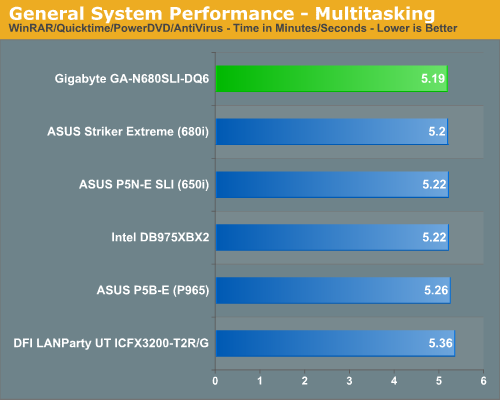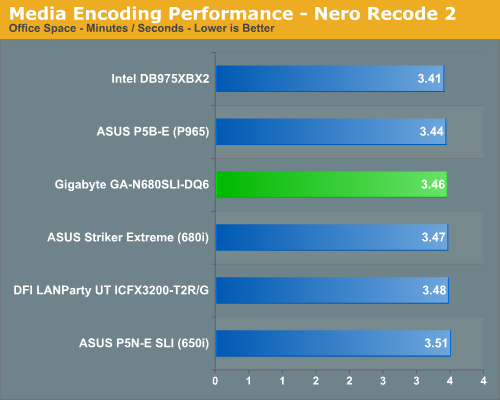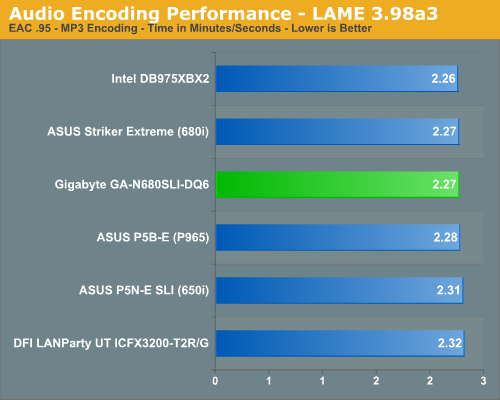Gigabyte GA-N680SLI-DQ6: Quad to the Extreme
by Gary Key on February 24, 2007 1:30 AM EST- Posted in
- Motherboards
General System Performance
We devised a script that would compress our standard test folder consisting of 444 files, ten subfolders, and 602MB worth of data, convert a 137MB High Definition QuickTime movie clip to a 37MB MPEG-4 format, play back the first two chapters of Office Space with PowerDVD, and run our AVG anti-virus program in the background. We stop the script when the file compression and video conversion are complete. This is a very taxing script for the CPU, Memory, and Storage subsystem. We also found it to be a good indicator of system stability during our overclocking testing.

The performance difference basically mirrors our PCMark 2005 tests with the 680i boards finishing first due to great disk performance, although the Intel chipsets consistently completed the QuickTime conversion first. The DFI RD600 board scores last although it generated the best video playback results. We also noticed it would stutter at times when converting the QuickTime file.
Media Encoding Performance
Our first encoding test is quite easy - we take our original Office Space DVD and use AnyDVD Ripper to copy the full DVD to the hard drive without compression, thus providing an almost exact duplicate of the DVD. We then fire up Nero Recode 2, select our Office Space copy on the hard drive, and perform a shrink operation to allow the entire movie along with extras to fit on a single 4.5GB DVD disc. We leave all options on their defaults except we disable the advanced analysis option. The scores reported include the full encoding process and are represented in minutes and seconds, with lower numbers indicating better performance.

We continue to see a strong performance from the Intel 975X in our application tests. In previous testing our ASUS 650i and 680i boards were almost two minutes slower in this test as we consistently found the performance of the 680i/650i to be lacking due to disk access issues. The conversion process would consistently slow down while the disk was being accessed. The quality of the video conversion was never affected but it appeared under heavy CPU usage that disk performance suffered. After the latest round of BIOS and driver updates these two boards now score close to the other chipsets.
Audio Encoding Performance
While the media encoding prowess of the P965 boards were superb in our initial media encoding testing, we wanted to see how they faired on the audio side. Our audio test suite consists of Exact Audio Copy v095.b4 and LAME 3.98a3. We utilize the INXS Greatest Hits CD that contains 16 tracks totaling 606MB of one time '80s hits.
We set up EAC for variable bit rate encoding, burst mode for extraction, use external program for compression, and to start the external compressor upon extraction (EAC will read the next track while LAME is working on the previous track, thus removing a potential bottleneck with the optical drive). We also set the number of active threads to two to ensure both cores are active during testing. The results are presented in minutes/seconds for the encoding process, with lower numbers being better.

As in the media encoding section, the more intensive CPU and storage system tests seem to favor the 975X over the P965/NV650i/RD600 when running at the same memory timings. Our two 680i boards are right on the heels of the 975X board with all scores being extremely close. Our Plextor drive consistently took two minutes and nine seconds to read all sixteen tracks. This means our test systems are only utilizing one core during testing until the midway point of the extraction process where the drive speed was exceeding the capability of the encoder and required the use of a second thread.
File Compression Performance
In order to save space on our hard drives and ensure we had another CPU crunching utility, we will be reporting our file compression results with the latest version of WinRAR that fully supports multi-treaded operations and should be of particular interest for those users with dual core or multi-core systems. Our series of file compression tests utilizes WinRAR 3.62 to compress our test folder that contains 444 files, ten subfolders, and 602MB worth of data. All default settings are utilized in WinRAR along with our hard drive being defragmented before each test.

In a complete reversal of the other application results we see our 680i boards finishing last. We see the Intel P965 and 975X chipsets leading once again as both seem to thrive in CPU intensive tasks. The DFI RD600 board continues to finish in the middle of the pack.
We devised a script that would compress our standard test folder consisting of 444 files, ten subfolders, and 602MB worth of data, convert a 137MB High Definition QuickTime movie clip to a 37MB MPEG-4 format, play back the first two chapters of Office Space with PowerDVD, and run our AVG anti-virus program in the background. We stop the script when the file compression and video conversion are complete. This is a very taxing script for the CPU, Memory, and Storage subsystem. We also found it to be a good indicator of system stability during our overclocking testing.

The performance difference basically mirrors our PCMark 2005 tests with the 680i boards finishing first due to great disk performance, although the Intel chipsets consistently completed the QuickTime conversion first. The DFI RD600 board scores last although it generated the best video playback results. We also noticed it would stutter at times when converting the QuickTime file.
Media Encoding Performance
Our first encoding test is quite easy - we take our original Office Space DVD and use AnyDVD Ripper to copy the full DVD to the hard drive without compression, thus providing an almost exact duplicate of the DVD. We then fire up Nero Recode 2, select our Office Space copy on the hard drive, and perform a shrink operation to allow the entire movie along with extras to fit on a single 4.5GB DVD disc. We leave all options on their defaults except we disable the advanced analysis option. The scores reported include the full encoding process and are represented in minutes and seconds, with lower numbers indicating better performance.

We continue to see a strong performance from the Intel 975X in our application tests. In previous testing our ASUS 650i and 680i boards were almost two minutes slower in this test as we consistently found the performance of the 680i/650i to be lacking due to disk access issues. The conversion process would consistently slow down while the disk was being accessed. The quality of the video conversion was never affected but it appeared under heavy CPU usage that disk performance suffered. After the latest round of BIOS and driver updates these two boards now score close to the other chipsets.
Audio Encoding Performance
While the media encoding prowess of the P965 boards were superb in our initial media encoding testing, we wanted to see how they faired on the audio side. Our audio test suite consists of Exact Audio Copy v095.b4 and LAME 3.98a3. We utilize the INXS Greatest Hits CD that contains 16 tracks totaling 606MB of one time '80s hits.
We set up EAC for variable bit rate encoding, burst mode for extraction, use external program for compression, and to start the external compressor upon extraction (EAC will read the next track while LAME is working on the previous track, thus removing a potential bottleneck with the optical drive). We also set the number of active threads to two to ensure both cores are active during testing. The results are presented in minutes/seconds for the encoding process, with lower numbers being better.

As in the media encoding section, the more intensive CPU and storage system tests seem to favor the 975X over the P965/NV650i/RD600 when running at the same memory timings. Our two 680i boards are right on the heels of the 975X board with all scores being extremely close. Our Plextor drive consistently took two minutes and nine seconds to read all sixteen tracks. This means our test systems are only utilizing one core during testing until the midway point of the extraction process where the drive speed was exceeding the capability of the encoder and required the use of a second thread.
File Compression Performance
In order to save space on our hard drives and ensure we had another CPU crunching utility, we will be reporting our file compression results with the latest version of WinRAR that fully supports multi-treaded operations and should be of particular interest for those users with dual core or multi-core systems. Our series of file compression tests utilizes WinRAR 3.62 to compress our test folder that contains 444 files, ten subfolders, and 602MB worth of data. All default settings are utilized in WinRAR along with our hard drive being defragmented before each test.

In a complete reversal of the other application results we see our 680i boards finishing last. We see the Intel P965 and 975X chipsets leading once again as both seem to thrive in CPU intensive tasks. The DFI RD600 board continues to finish in the middle of the pack.










12 Comments
View All Comments
sirius4k - Thursday, May 17, 2007 - link
Overview in Gigabyte' website said there will be some eSATA (Quad eSATA or something) ports. On this preview... read panel indicates no eSATA ports :S---
No eSATA means going back to Striker Extreme... of course.
yacoub - Friday, March 30, 2007 - link
The reviews at NewEgg are tearing this board a gaping butthole. I'm staying away. :[Gary Key - Monday, April 2, 2007 - link
Every review at NewEgg was either a four or five star rating for this board. Where are the bad ones?Binkt - Monday, March 19, 2007 - link
Can someone over there put in a few PCI-E RAID cards in those extra PCI-E slots and see if they function? The Areca SATA RAID cards (ARC-12x0ML) are what I'm looking at right now. Pretty please?!There is a rather cryptic FAQ entry on using PCI-E for "graphics" slots on Areca's website in regards to this subject. I'd just like some more physical validation before plunking down the green.
erwos - Monday, February 26, 2007 - link
Am I the only one who's totally and utterly confused as to why this board has four ethernet interfaces? I can see using two interfaces. I could even contemplate three for really weird setups. But what networking setup requires four gigabit interfaces? Are they supposed to be bonded, or used for fail-over?Speaking purely as a gamer, the MSI P6N Diamond looks like a better deal. It may be shorter on the ports, but that built-in X-Fi seems a lot more handy than a couple more SATA and ethernet ports.
Gary Key - Monday, February 26, 2007 - link
1. XP Professional will show 3.25GB of RAM when 4GB is installed. The board will show 4GB at POST.2. The RAM timings will drop with 4 x1GB when overclocking, at stock speeds with the F3 BIOS they require an additional .0125V to operate at the same timings.
3. The timings matter when using 2x2GB compared to 2x1GB,512MB, however at same timings we found 2X2GB was generally more stable and performance did not vary more than a percent or two.
4. If you use a 32-bit OS such as XP you are limited to 3.25GB of usable memory space.
5. This board did not have an issue with Vista-64 and recognizing 4GB or 8GB of memory, as stated in the article we are still conducting memory compatibility testing as certain modules perform better than others (stability, voltages, timings), even though they are based on the same IC. Gigabyte still has some tuning work to do in this area.
Thanks, more information will be in the roundup.
anandtech02148 - Saturday, February 24, 2007 - link
per example dfi infity 975g requireds 300watts just to post.also what is the idle /load for this? more electricity mo heat.
cornfedone - Saturday, February 24, 2007 - link
...or don't. As long as gullible, foolish fanboys buy these defective products, there is no FINANCIAL incentive for these unscrupulous companies to change their ways and deliver quality products.Obviously if every hardware review site on the planet can duplicate the unending operational (and often design/engineering) defects in these mobos, then certainly the mobo and chip makers could detect these defects BEFORE they ship this crap if they weren't intentionally pumping garbage out the door to suckers willing to pay $200 plus for a mobo that is a total POS.
There is absolutely NO reason to release a defective hardware product today other than financial greed and/or technical incompetence. Hell most of the Asian mobo companies can't even make a friggin quality copy of a reference mobo from AMD or ATI so why would you expect them to deliver a properly functioning "performance mobo" priced at hundred of dollars more when they can't buy a clue?
With any luck all of the slimy mobo makers will go tits-up soon and the real mobo companies will see an opportunity to provide quality mobos to the marketplace. At $200 a copy there is one Helleva incentive for honest, competent mobo companies to step forward and waste the Asian scum who are dumping crap into the marketplace. When a $200 plus mobo causes data corruption it's time for a massive class action lawsuit to end this consumer fraud and exploitation.
Now is the time.
sdsdv10 - Tuesday, February 27, 2007 - link
Cornfedone, what major motherboard manufacturer isn't in Asia? It appears you are painting all the current companies with the same bruch, Asus, Gigabyte, abit... Who would be left to be the "honest, competent mobo companies"?
tuteja1986 - Sunday, February 25, 2007 - link
Well Gigabyte GA-N680SL-DQ6 isn't even selling it. It will sale next month. They still have time to fix the bugs. Anyways i say buying the striker at launch for $400 was a foolish thing to do since it was buggy as hell. It took for them months to fix the problem.